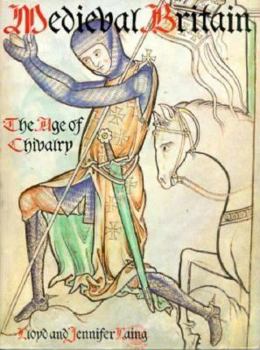Medieval Britain: The Age of Chivalry
Select Format
Select Condition 
Book Overview
A tableau of medieval life put together using evidence of art and architecture. With sections on urban, rural and court society, the art and traditions of the Church and the role of women, this book... This description may be from another edition of this product.
Format:Hardcover
Language:English
ISBN:0312162782
ISBN13:9780312162788
Release Date:January 1996
Publisher:St. Martin's Press
Length:224 Pages
Weight:1.90 lbs.
Dimensions:0.9" x 7.6" x 10.1"
Related Subjects
16th Century Education & Reference England Europe History Ireland Modern (16th-21st Centuries) WorldCustomer Reviews
1 rating
A different world
Published by Thriftbooks.com User , 18 years ago
The book 'Medieval Britain: The Age of Chivalry' by Lloyd and Jennifer Laing is a pleasure to read in many ways. It is a well-constructed book, with good, thick pages, most of which have illustrations, and many of those are in full-colour plating. The images add life to the interesting text, designed to bring to life the world of the medieval Britons in art, architecture, royal history, culture, church history, and science and technology. 'The Middle Ages traditionally begin with the arrival of William of Normandy in 1066, and end in 1485 with the Battle of Bosworth.' Within this lengthy period (a timespan more than half as long again as the existence of the United States), a wide range of activities and developments occurred, but in many ways this was also a stable period of time for the larger majority of people, despite the continuing problems of warfare and disease. One of the more variable aspects of this time period has been the way in which it has been interpreted - 'The imperialist Victorians saw the Normans as introducing a superior culture to a backward nation. Reaction to this view in the post-World War II era tended to paint the Normans as primitive villains who trod mercilessly across the civilised face of Anglo-Saxon England.' Part of this narrative deals with the culture and worldview of how the medieval peoples saw themselves. The legends of King Arthur arose in this period with considerable strength, and the international character of the times, of dealings with the different peoples in the British Isles and the continental peoples, not to mention the peoples reached during the various Crusades, gave a continuing source of inspiration to people. The Laings draw on many sources for their narrative. Among these sources include archaeological discoveries and still-existing structures from the period. The growth of urban archaeology in the post-World War II rebuilding of many towns and cities added much to the information of this period. Also, written records from government and church sources are often preserved - the later the period, the fuller the written accounts. Urban areas and towns often had official registers, as did many manors, monasteries, and other institutions. There is a brief index included at the back, and a two-page list of further readings. Unfortunately, there is no list of all of the photographs and graphic images - there are literally hundreds scattered throughout the text, and some are referenced in the index. Many of the images were taken by Lloyd and Jennifer Laing themselves. There are also reproductions of stained-glass windows, illuminated manuscript pages, and other primary source material. For example, the section on science and medicine includes a page from a medieval anatomy (an anatomy professor at my college said, 'the books then weren't as accurate, but were more interesting') complete with drawings and commentary. This is a fascinating book.




